The People in 1971
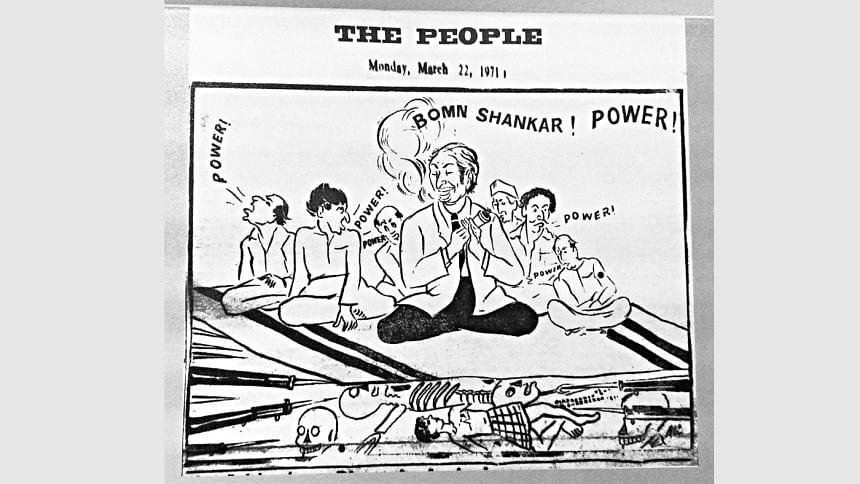
As per the blueprint of Operation Searchlight, the Pakistani army had four key targets in Dhaka city on the fateful night of 25 March 1971. These were Dhaka University Campus, Rajarbagh Police Lines, Pilkhana—the headquarters of the East Pakistan Rifles (EPR)—and Dhanmondi 32, the residence of Bangabandhu Sheikh Mujibur Rahman. However, there was another target they aimed to burn down: the office of the English newspaper The People. On that night, another protagonist of the Pakistani genocide against the Bengalis, Zulfikar Ali Bhutto of the Pakistan People's Party, was resting in the presidential suite of the Continental Hotel at Paribagh, near Shahbagh. From the window of his luxurious room, he witnessed the destruction of the newspaper with his own eyes.
So, why did the barbaric Pakistani forces target The People as a prime objective of Operation Searchlight? The answer is simple: The People was the strong voice of the Bengali non-cooperation movement led by the Awami League. To understand this, we can focus on one particular publication of The People from 1971.
On 23 March, Pakistan Day was observed in then-united Pakistan. It was a national holiday in 1971, typically a day of celebration and solidarity in Pakistan, marked by various events. The practice of hoisting Pakistani national flags on offices, buildings, road islands, and other public places was widespread. However, 23 March 1971 was a very different day in Dhaka. On this particular day, the citizens of Dhaka hoisted Bangladesh flags all over the city. To portray this, The People published a cartoon on 24 March titled, 'Sir, I don't see any sign of Pakistan anywhere else'. The cartoon illustrated a Pakistani high official, perched atop a watchtower, unable to find any Pakistani flags across the city. In contrast, a new flag of the emerging state fluttered in the rebellious air of Dhaka. On 24 March 1971, The People also published a banner headline that read:
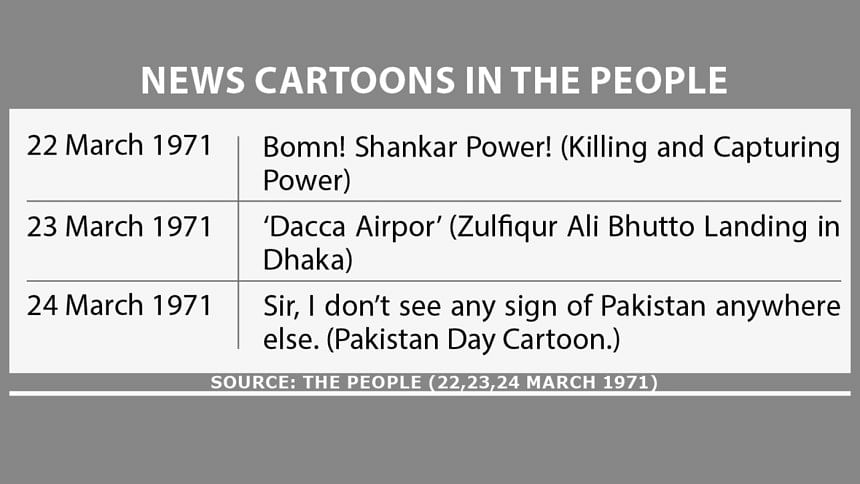
'A FLAG OF FREEDOM IS BORN WITH STAIN OF MARTYRS' BLOOD'.
As part of a special report, the banner headline story narrated:
A new nation is born. And with it, a new flag—stained with the blood of martyrs—the flag of "Swadhin Bangla". In the serene calm of the dawn of 23 March, the new flag, hoisted atop all public and private buildings, offices, and establishments, fluttered proudly in the air, marking the advent of a new era for the Bengali nation. The day, observed as a day of resistance against the onslaught on our freedom, was charged with profound emotion and filled with high expectations.
The day that was observed as a day of resistance against the onslaught on our freedom was charged with utmost emotion and pregnant with high expectations. The emotion is linked with breathing the air of a free country, and the expectation entails building up Bangladesh as a full-blossomed and progressive independent polity. (The People, 24 March 1971)
My observation is that it was not only the publication of 24 March 1971, but the entire coverage of the Bengali non-cooperation movement that infuriated the Pakistani army, making them furious with the newspaper The People.
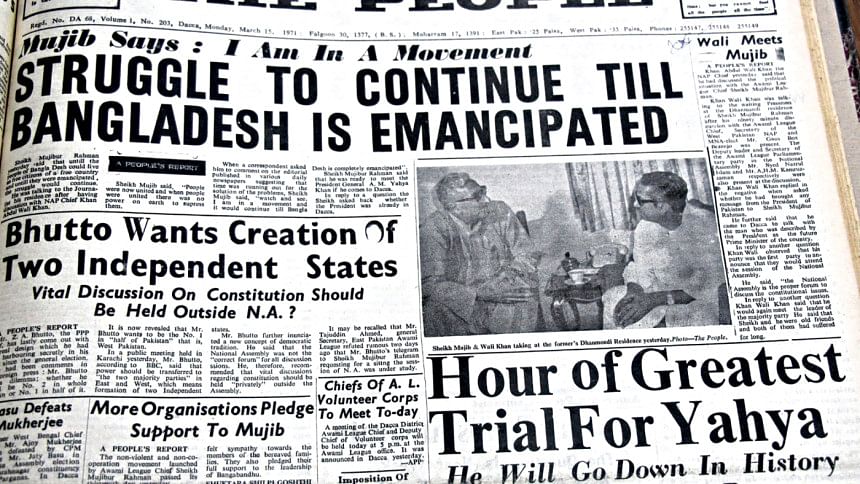
In headlines, news narratives, photographs, cartoons, and editorials, The People was wholeheartedly supportive of the Bengali uprising. It should be noted that this support began as early as 2 March 1971.
On 1 March 1971, in a radio announcement, the then Pakistani President Yahya Khan postponed the National Assembly session in Dhaka. This sparked a wave of protests across Dhaka and the rest of the country. On 2 March 1971, The People published the news under the headline:
'Mujib's call for emancipation of Bengalees'.
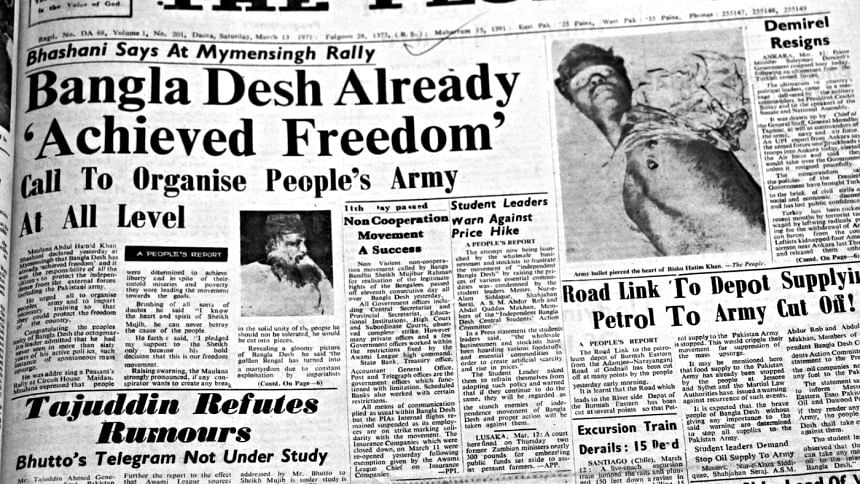
'Emancipation' refers to the process of being set free from legal, social, or political restrictions—essentially, liberation. By using the term 'emancipation', The People underscored the freedom movement from 2 March 1971. This was not an easy task; in fact, it was a risky one. The bold introductory statement read:
'Sheikh Mujibur Rahman, the Awami League Chief, while talking to the pressmen immediately after the parliamentary party meeting at Hotel Purbani following the announcement of the postponement of the N.A. session, said that he would make all sacrifices for the emancipation of the 70 million Bengalees. He further said that a united fight has to be put up for ending the colonial treatment to which Bengalees have been subjected for the last 23 years.' (The People, 2 March 1971)
An Extraordinary Editorial
Maverick, independent-minded journalist Abidur Rahman was the editor of The People in 1971. Under his guidance, The People began its journey as a daily newspaper on 15 August 1970. Prior to that, The People was a weekly magazine. From the outset, The People served as the voice of the Bengalees. During the non-cooperation movement, on 11 March, The People published an extraordinary editorial. The title was 'A New Nation Is Born In Bangla Desh'. This front-page special editorial described the situation as follows:
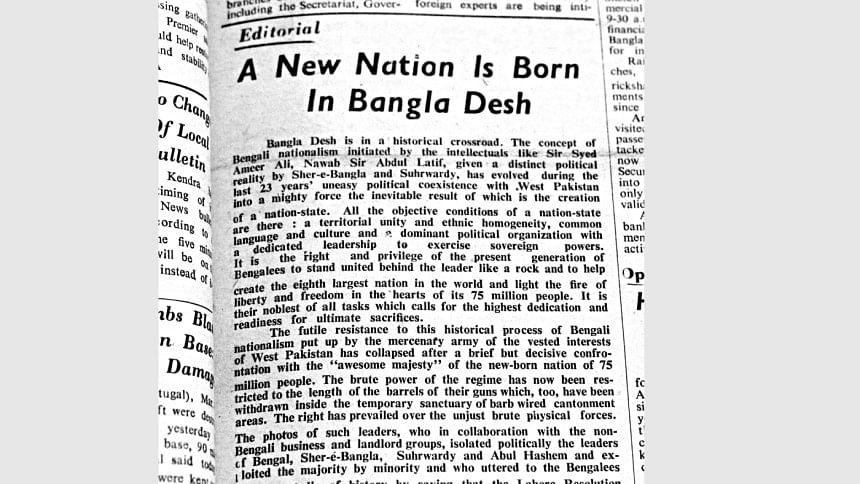
'Bangla Desh is in a historical crossroad. The concept of Bengali nationalism initiated by the intellectuals like Sir Syed Ameer Ali, Nawab Sir Abdul Latif, given a distinct political reality by Sher-e-Bangla and Suhrawardy, has evolved during the last 23 years' uneasy political coexistence with West Pakistan into a mighty force the inevitable result of which is the creation of a nation-state. All the objective conditions of a nation-state are there: a territorial unity and ethnic homogeneity, common language and culture and a dominant political organisation with a dedicated leadership to exercise sovereign powers. It is the right and privilege of the present generation of Bengalees to stand united behind the leader like a rock and to help create the eighth largest nation in the world and light the fire of liberty and freedom in the hearts of its 75 million people. It is their noblest of all tasks which calls for the highest dedication and readiness for ultimate sacrifices.' (The People, 11 March 1971)
Crackdown and Killing
Poet Nirmalendu Goon was working as a trainee sub-editor at The People in 1971. He was working under the prominent journalist Anwar Zahid. At that time, Gonobangla—a weekly publication of The People—was being published under the leadership of Anwar Zahid. Nirmalendu Goon was working specifically for Gonobangla. For research purposes, I had the opportunity to interview Poet Nirmalendu Goon about 1971. He told me that The People was one of the major targets of the Pakistani army under Operation Searchlight due to the outspoken nature of the newspaper.
In the first phase of the attack, the Pakistani army targeted The People's office. They set fire to the office using gunpowder. Tanks also shelled the office with machine gunfire. Nirmalendu Goon also told me that, during this attack, 4–5 workers at the office were killed.

At that time, the editor of the newspaper was at his home near Paribagh. He received a phone call from one of the office staff members, informing him that a Pakistani army tank was near The People's office. That was the last phone call before the telephone lines went dead.
It was a kind of fateful irony that the editor of The People saw the high flames of his own office from the rooftop of his residence. Later, he learned that a few office staff members had been killed in the attack. One was a worker from the printing press, and two other boys—Esha from Shahbajpur in Brahmanbaria, who cooked the meals, and Fazlu from Barisal, who served them—were shot dead that night.
When the editor of The People returned to the office after 16 December 1971, they found two broken skeletons lying in the ruined and ravaged office of The People.
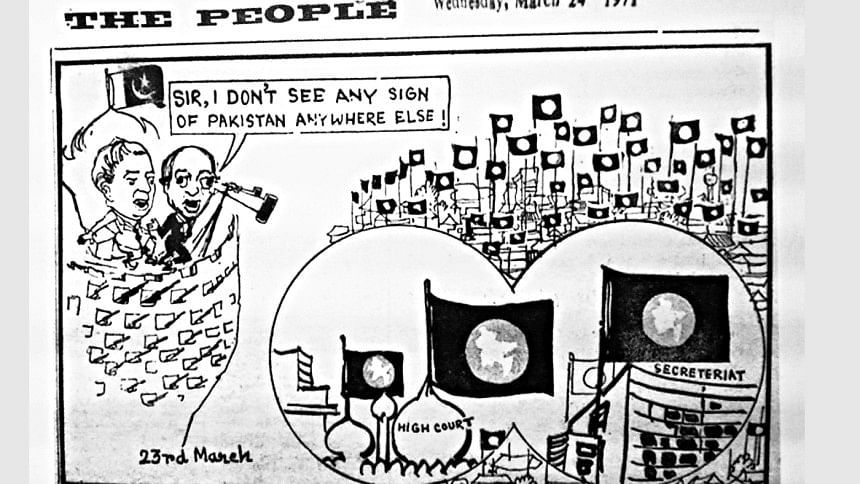
Sources:
• Salik, Siddiq (1997), Witness to Surrender, Dhaka: University Press Limited.
• Interview, Poet Nirmalendu Goon (2021)
• First-hand account of Operation Searchlight, The Daily Star, 26 March 2012
https://www.thedailystar.net/news-detail-227687
Note:
• In 1971, The People wrote 'Bangalees' as 'Bengalees'.
Rahat Minhaz is an Assistant Professor in Mass Communication and Journalism at Jagannath University, Dhaka. He can be reached via email at: [email protected]

 For all latest news, follow The Daily Star's Google News channel.
For all latest news, follow The Daily Star's Google News channel. 


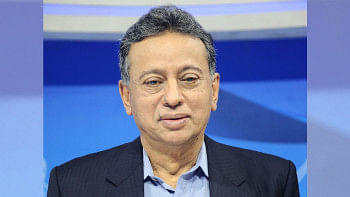
Comments